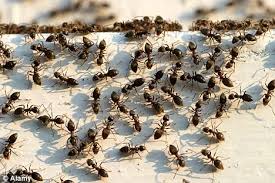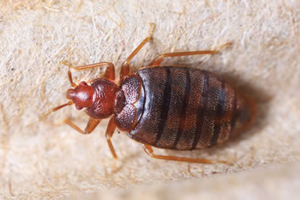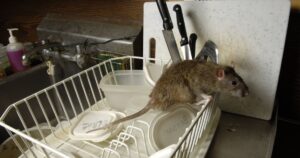This time of year we look forward to spending time with family and friends, enjoying and sharing the warmth of our homes and plenty of wonderful food. Even the stress of traveling is overshadowed by the excitement and anticipation of being with those we love or in the places we look forward to visiting.
Spending time cleaning up ants in the kitchen while trying to celebrate with family, bringing home bed bugs after a wonderful holiday vacation, or just hearing the patter of feet in the attic on a cold winter’s night can ruin your holiday spirit.
Here are some tips to keep your holidays a bit less stress filled.
Ants: How to prevent an invasion.
- Practice good sanitatio
 n measures especially in the kitchen. Ants are attracted to the food we leave behind.
n measures especially in the kitchen. Ants are attracted to the food we leave behind. - Cover food and liquid substances tightly and keep surfaces clean.
- Sweep floors and vacuum your carpets. The tiniest crumbs can attract ants.
- Always cover and seal the food that’s not in the fridge.
- Do not leave dirty dishes in the sink.
- Keep trash cans and bins clean and take the trash out often.
- Keep your countertops dry. Don’t allow liquids to accumulate on counters and other surfaces. Ants look for water wherever they can find it.
- Fix dripping faucets.
- For more information visit our ant control page.
Bed Bugs: Don’t bring them home with you.
- Do not put y
 our clothing or luggage directly on any bed. If bed bugs are present in the bed, they can climb into bags, suitcases or any laundry left on the bed.
our clothing or luggage directly on any bed. If bed bugs are present in the bed, they can climb into bags, suitcases or any laundry left on the bed. - Use metal luggage racks at all times. Bed bugs cannot easily climb metal surfaces, so they make an ideal overnight spot for your suitcase. Keep the rack away from the walls and any wooden furniture.
- Use small plastic bags to pack clothing, shoes, and other personal items. This will help prevent any bed bugs that climb into your suitcase from getting into your house with your clothing. Bed bugs will also hide in books, cloth toiletry kits, and other non-metal personal items.
- Hotels aren’t the only bed bug travel threats. Bed bugs thrive in dark, cool places with long-term access to humans. They can also be found on airplane and train seats, buses, or in rental cars.
- When you return home, leave your luggage in the garage, and immediately launder all cloth items. The first places bed bugs typically encounter are bags and suitcases so keeping your luggage outside may help keep them out of your home. Depending on where you live, keeping luggage outdoors may also leave bed bugs outside their comfortable range of temperatures. You can also eliminate bed bugs that may have gotten into clothing by laundering (washing and drying) all fabric items in hot water, although recent studies show that 20 minutes in a clothes dryer is all that is needed to ensure 100% control.
- Don’t forget to treat your empty bags and luggage (with an appropriate bed bug product) before taking them into the house or putting them in storage.
- Need more information? Visit our bed bug services page.
Rats: How to keep them out of your home.
Make sure y our property is well-manicured. Get rid of clutter! Rats are fond of using trees, vines and large shrubs as ladders to access upper stories and roof areas. Dense foliage and ground cover need to be thinned out or removed. Eliminate weeds, and prune trees and vines back so they don’t touch the structure of the home or buildings on the property. our property is well-manicured. Get rid of clutter! Rats are fond of using trees, vines and large shrubs as ladders to access upper stories and roof areas. Dense foliage and ground cover need to be thinned out or removed. Eliminate weeds, and prune trees and vines back so they don’t touch the structure of the home or buildings on the property.
Don’t feed the rats. Keep pet food in closed containers and never leave it outside in open dishes, especially overnight. Clean up under and around bird feeders — rats are attracted to nuts and seeds. Pick up fallen fruit from the ground, and harvest your fruit and garden produce regularly. Clean your BBQ well — rats love leftovers and even a little grease can attract them! Finally, keep your garbage cans lidded and never leave trash in plastic bags outside. Rats need water. Keep irrigation equipment in good condition and fix any leaks. Do not leave any pools of water outside like pet water bowls. Maintain pool equipment and keep storage boxes locked. Bird baths and fish ponds may also attract rats, so bear this in mind when you determine their importance to your property. |
| Inspect the exterior of the home or building to determine possible entry points. All openings to interior spaces greater than one half-inch (1/2″) should be sealed. Exclusion is an important rodent control technique that should be done before rats get into the structure or after rats have been evicted or removed. Sealing rats inside will lead to the destruction of your property as they try to escape and eventually die inside your home.
Locate access points for rodents where utility lines come into walls, as well as openings around air conditioning units, drain pipes and vents. Look for broken windows, warped doors, and unscreened vents as possible points of entry. All spaces beneath doors should be checked to see if the opening is too large. Reduce any openings as needed (remember, one half-inch (1/2″) is all the space a rat needs to gain entry). Roofs should be checked to see that shingles and tiles are in good repair and that sheathing is complete. Also, check roof ventilators and louvered-in wall vents. Rats need to be eliminated from your home. The safest and most effective rodent extermination methods are those performed by a pest control professional. Click here for more information about rat control. HAVE A PEST-FREE HOLIDAY SEASON! |
 800-901-1102
800-901-1102
Thank you for all the wonderful information. K